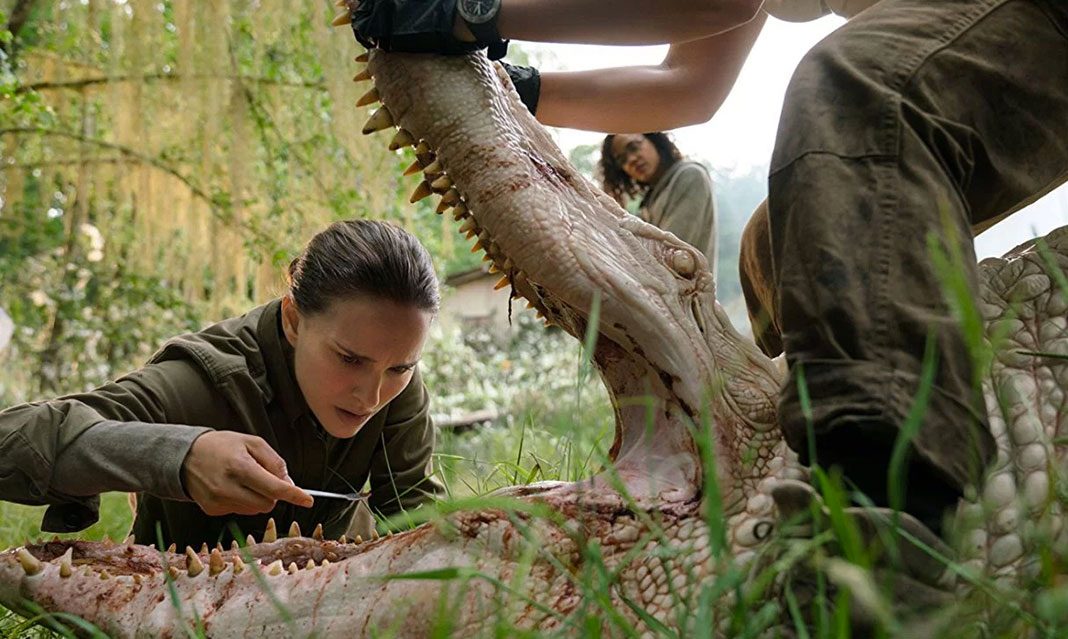Alex Garland’s Annihilation is more than just a sci-fi horror film. It visualizes inner conflict and self-confrontation in a unique way. This spoiler review explores how the film deals with themes of trauma, mental illness, and the nature of personhood through a science-fiction lens.
The film opens with an outer-space object striking a lighthouse, from which a mysterious field starts spreading and becomes known as the Shimmer. The field is sealed off and deemed “Area X.” The only person to return from the Shimmer is Kane, a U.S. soldier and husband of the protagonist, Lena, who happens to be a cellular biology professor as well as a former soldier. Kane returns strange, altered, extremely ill, and is taken back to Area X along with Lena.
To uncover the mysteries of the Shimmer, Lena heads out on an expedition with psychologist Dr. Ventress, paramedic Anya Thorensen, physicist Josie Radek, and geologist Cass Sheppard. Inside, the group encounters mysterious and beautiful creatures, mutations, and hybrid species—some more dangerous than others. Josie suggests that the Shimmer is an electromagnetic field that doesn’t block outside forces so much as it refracts them, in essence, altering them forever. They soon reach the conclusion that the Shimmer refracts every single thing, even the cells in their own bodies. The second they stepped inside the field, they started to change.
Annihilation is nothing if not about change—or rather, unraveling. Each member of the group harbours personal grief or trauma. In a conversation between Cass and Lena, we find out about the death of Cass’s daughter, Anya’s struggle with alcoholism, Dr. Ventress’s cancer diagnosis, and Josie’s battle with depression and self-harm. Certain transition scenes flashback to Lena’s conflict—compromising acts that could harm her marriage. The deeper that the group heads into the Shimmer, the more their layers peel off to reveal complex, broken individuals.
In an article titled “Annihilation and the Horrors of Change,” the author, who writes under the penname FilmCritHulk, writes, “But at center of [Annihilation] is not some lesson about the mere gravity of mental health, but more the painful understanding of collective human behavior. […] You will have to face the thing you are most afraid of. We all have a potential annihilation to face.”
What’s striking about this analysis is its suggestion that life is essentially an intricate web of individual journeys that contribute to a collective journey. Annihilation reveals a remarkable yet horrifying truth about human existence: the ability of human beings to feel inevitably connected yet utterly isolated simultaneously.
One by one, the group breaks apart. Some meet brutal ends, others journey alone, choosing either to surrender to their grievances or to embrace them. Everything inside the Shimmer personifies those battles and grievances, constantly refracting, changing, unraveling. In a beautiful sequence of scenes, Josie decides to embrace the Shimmer, never meaning to question it, but simply becoming a part of it. Vines of flowers and leaves sprout from her scars and entwine around her arms, legs, and eventually her entire body. She comes to terms with her conflict by succumbing to it.
Lena journeys to the lighthouse alone and reaches the core. In a climactic scene, Lena confronts what seems to be her clone. It shadows her every move, fights back when Lena attacks, and rushes atop her when she tries to escape. In an article from Vulture, titled “How Annihilation Nails the Complex Reality of Depression,” Angelica Jade Bastién notes, “[Annihilation is] a masterwork I felt in my nerve endings, a brutal, gorgeous meditation on the rigors of depression and the human impulse toward self-destruction.” The movie certainly gives shape to the experience of mental illness, daringly and blatantly at times. However, it is only one possible depiction, since there is no way to portray a singular universal experience of depression or other mental illnesses.
With Annihilation, director Garland imagines a world of change, one where growth comes through destruction. It starts at the cellular level, or perhaps deeper still, from an unseen inexplicable force that expands and evolves into something uncontrollable. From the moment we are born, we head towards inevitable death. It’s the journey that matters.



